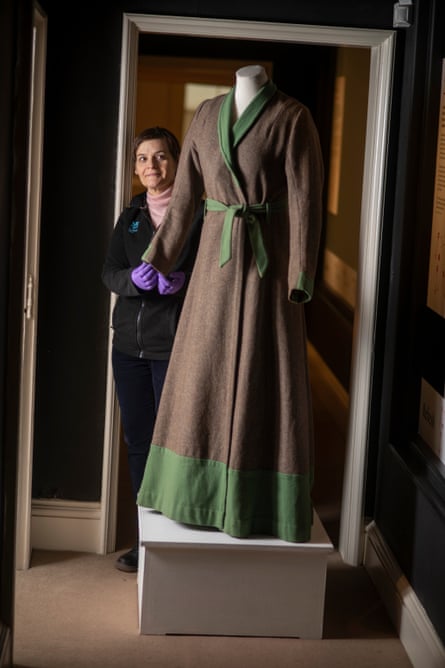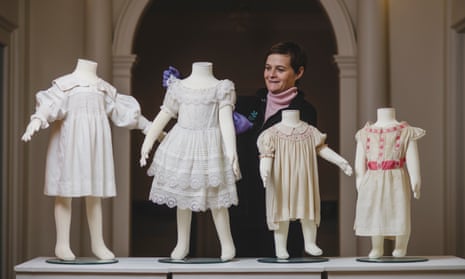Some of the garments in the exhibition are made of elegant silk, others of rough-looking wool or scratchy nylon – but what they all have in common is that they have been repaired, remodelled and reused, sometimes over the course of centuries.
There is a long-sleeved waistcoat made in the late 17tth century and then adapted and preserved over 300 years, wedding dresses handed down from mothers to daughters and brought up to date with clever tweaks, even clothes that were created during the second world war out of parachutes and old army blankets when fabric was rationed.
The garments are part of the Thirsty for Fashion exhibition opening at the National Trust’s Killerton House in Devon. The aim is to make people think about how they buy and look after clothing in this fast-fashion, throwaway world.
“Recycling and reusing clothing has been commonplace throughout history,” said Shelley Tobin, the costume curator at Killerton. “This exhibition asks the question: can we learn lessons from these past practices and reapply forgotten skills to look after our clothes and make them more sustainable?
“The items exhibited show that we only need look to history to discover ways to ensure that the clothing we buy, make and wear is durable, ethical and avoids waste.”
The exhibition begins with T-shirts emblazoned with sobering facts about clothes waste. They say 300,000 tonnes of clothing is put into landfill every year in the UK and it takes 3,781 litres water to make one pair of jeans.
In contrast, the highlight of the first room is a sleeved waistcoat made of silk in about 1690. It was handed down through the generations and at one point the horizontal pocket flaps were replaced with more fashionable vertical ones. In the early 20th century it was turned into a fancy dress costume and in the 1980s someone conserved it by relining it.

Tobin said some modern makers were reusing clothes and fabric. So in the same cabinet as the waistcoat is a much more modern piece, a suit made in 2022 out of old denim jeans by the London fashion company ELV Denim.
Another highlight is a “transformation dress” made in 1870 and consisting of a billowing skirt that could be matched with a modest long-sleeved, high-cut bodice for the day or a more risque one for the evening. “It was made of expensive material so they wanted to get the most use out of it possible,” said Tobin.
One feature of the exhibition is the testimony of friends and volunteers of Killerton – home to the National Trust’s biggest fashion collection with more than 20,000 items of historical clothing and accessories – about their favourite vintage pieces.
Charlotte Eddington, for example, describes her beloved 1970s woollen Guernsey jumper that she persuaded her dad to hand down to her when it became too tight for him. It reminds her of camping and fishing in Northumberland as a child.
after newsletter promotion
Sarah Parry, a gardener, tells how she wore her mother’s 1985 wedding dress when she got married last year. “It’s so floaty and frothy and ethereal,” she said. Parry added a green waistband give it a modern twist. “It was so fulfilling to give the dress a second life.”
A striking set of clothes on display was made during and after the second world war when fabric was rationed and the government launched the “make do and mend” campaign. “It was very difficult to get hold of most fabric,” said Tobin. “If you could come by, for example, a parachute you could use it.”
The show includes a nightdress made in about 1943 from a nylon parachute – but Tobin’s favourite piece is a dressing gown made in the late 1940s by an Exeter woman out of surplus army blankets livened up with a beautiful green trim and belt.
“I think it’s ingenious that she made it into this very elegant and durable dressing gown,” said Tobin. “We hope the exhibition will lead to discussions about whether we can learn from past practices and reapply forgotten skills to look after our clothes, and how can fashion respond to the changing climate, environmental concerns and the cost of living crisis.”
The exhibition runs from 11 February to 5 November 2023.
